By Phil McCoy
Captain Frank Smith Robertson, an assistant engineer on JEB Stuart’s staff, recounted a meeting in Maryland with Gen. Robert E. Lee during the withdrawal from Gettysburg:
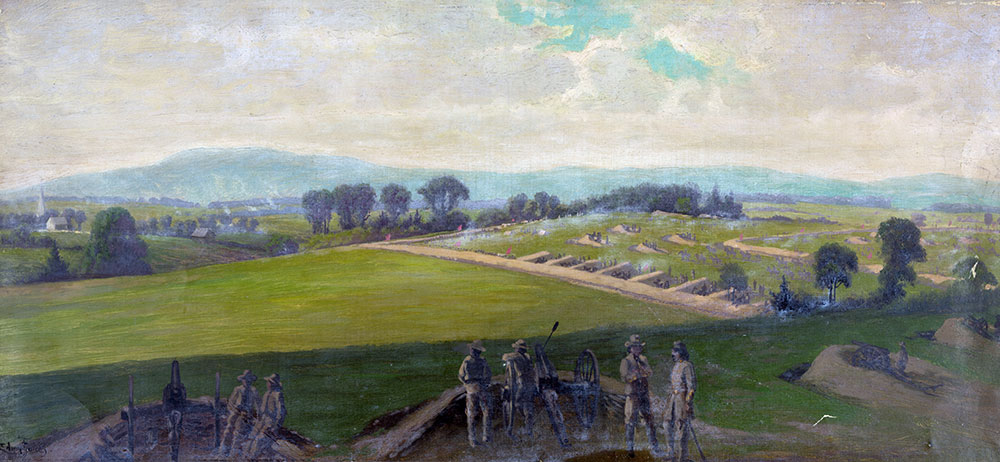
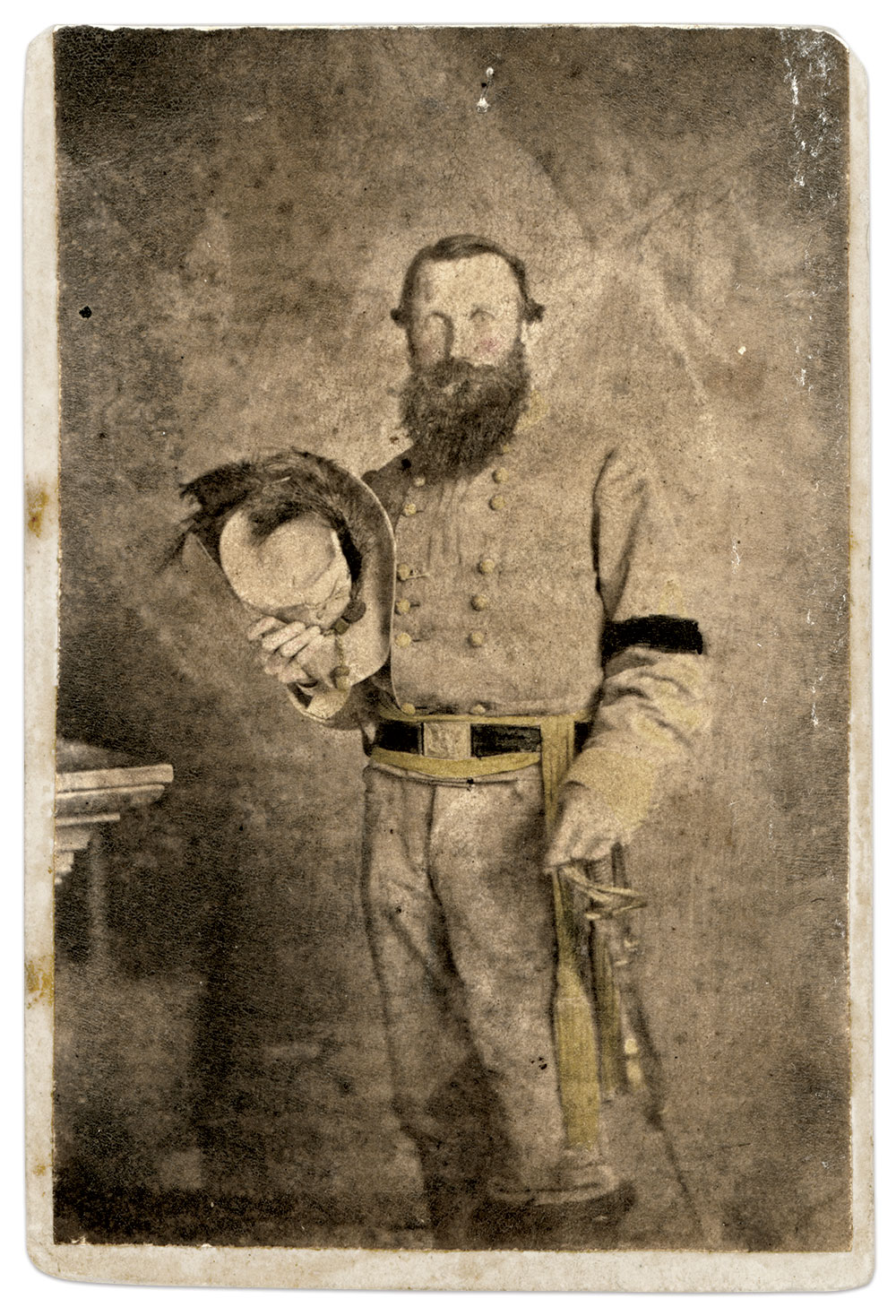
“We reached Hagerstown O.K., our cavalry following and protecting the rear of our retreating army. Breastworks were thrown up around the town, and we awaited an attack. I was sent by General Stuart with a message to General Lee. I wrote it in my pocketbook and also in my memory. I found General Lee sitting alone in a piece of woods. There was not a staff officer nor anybody around except a lone courier, who held my horse during the interview. Marse Robert greeted me in a Kindly, almost fatherly way, and said, ‘Come, my boy, what news of the cavalry.’”
While Lee pondered the next moves for his Army of Northern Virginia, Stuart and his staff made a temporary headquarters in the vicinity of Hagerstown. At some point during his stay, Stuart posed for this portrait in the downtown studio of local photographer Elias M. Recher.
Recher captured Maj. Gen. James Ewell Brown “JEB” Stuart at the zenith of his military career. The Virginian had received accolades from superior officers and the press for his hard-fought victories. His battlefield prowess and cavalier style in dress and manner reinforced his image as beau sabreur of the Southland. In death, his reputation grew as one of the greatest American cavalry commanders ever foaled.
Glory and sacrifice on the journey to Gettysburg
How Stuart came to pose in Recher’s gallery traces back to the beginning of his army career. He began his chosen profession as a soldier in a deeply divided America. Following his graduation from West Point in 1854, he participated in quelling bloody violence in Kansas Territory as pro- and anti-slavery forces battled for statehood, and the capture of abolitionist John Brown after his failed attempt to ignite a slave insurrection at Harpers Ferry, Va.
Resigning his U.S. Army commission in May 1861 to join the Confederacy, he established a reputation as an aggressive cavalry commander in the Shenandoah Valley with Stonewall Jackson, and leading audacious raids around the U.S. Army of the Potomac during the Peninsula and Antietam campaigns.
Stuart’s appetite for fame, one can only assume, grew as the war waged and led to precarious situations. One of them, the Battle of Kelly’s Ford in March 1863, cost him the life of his trusted artillery chief, John Pelham.
Stuart issued a remorseful yet glowing tribute to Pelham in General Orders No. 9. He noted, “To you, his comrades, it is needless to dwell upon what you have so often witnessed—his prowess in action always proverbial.” The bereaved general went on to declare 30 days of mourning to be marked by black crepe armbands to be worn by artillery and division staff. He referenced Pelham’s passing in letters to his pregnant wife, Flora, requesting she name the child in honor of the fallen artillerist.
Two months later at Chancellorsville, Stuart lost another beloved staffer. Major Richard Channing Price, his assistant adjutant general, who was killed by artillery fire. Stuart again called for division command to wear mourning ribbon in Price’s honor.
Chancellorsville also marked a new high point for Stuart. He performed well as temporary commander of the Army of Northern Virginia’s 2nd Corps after the accidental wounding of Jackson. After he succumbed to his wound, some bandied Stuart’s name about as the late general’s successor. Major General Thomas L. Rosser told Stuart that Jackson whispered on his deathbed that Stuart should have his Corps. General Lee ultimately placed Lt. Gen. Richard S. Ewell in command of the corps.
After Chancellorsville. Stuart made his headquarters about 25 miles northeast in Culpeper. His troopers were in great shape and high spirits. A feeling of invincibility imbued the ranks. Stuart celebrated the moment with a grand review of his entire corps on June 5 at Brandy Station, about a dozen miles from his Culpeper headquarters.
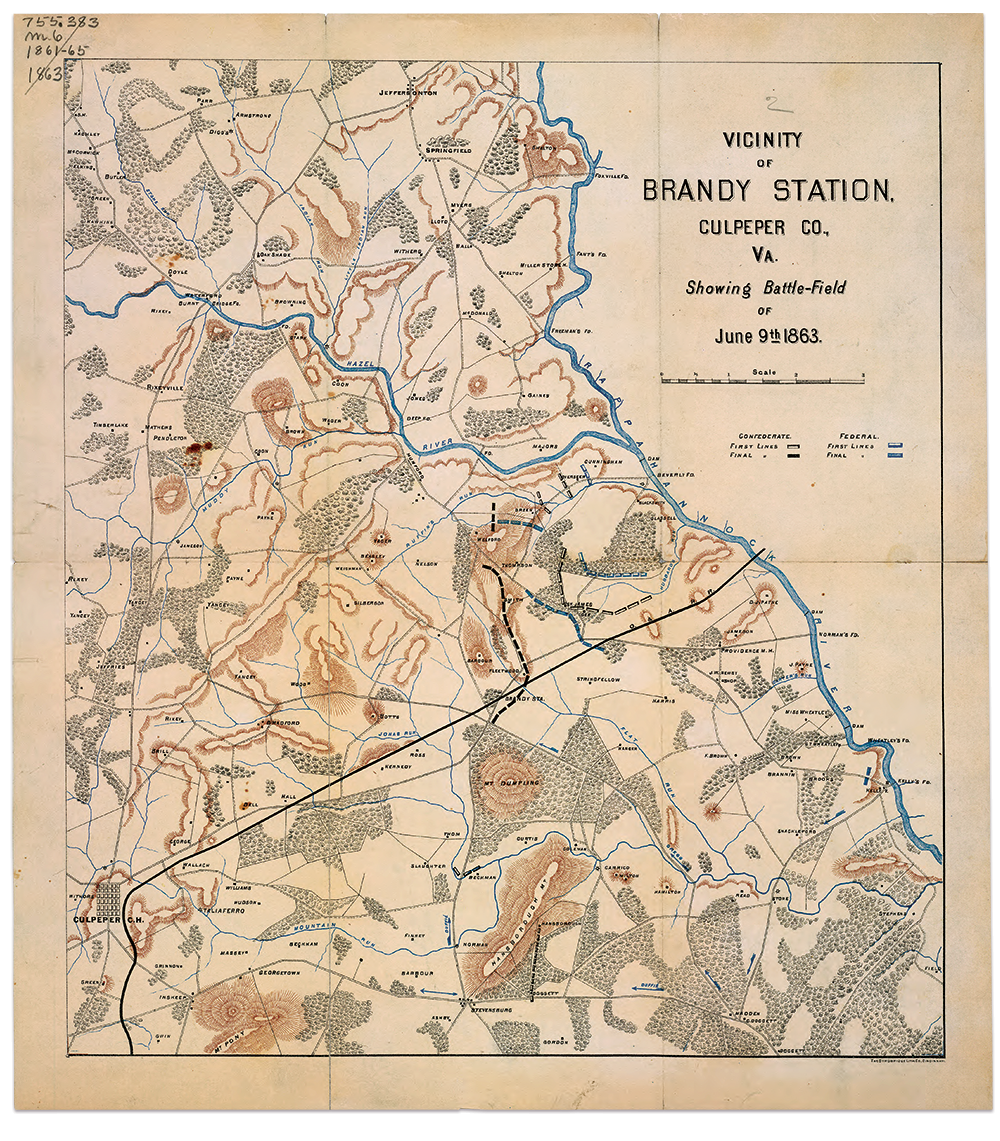
The review unfolded on a long, wide field on the farm of John Minor Botts, a Virginia-born politician with strong Unionist views.
That morning, Stuart and his staff joined about 8,000 mounted men on steads of every color, lined up for almost two miles, with battle flags gently blowing in the morning breeze, the men one by one stroked the mane of an unruly horse or adjusted a sword belt and its cherished blade, field officers bellowing commands of “steady.”
Everyone dressed in their best uniforms. The charismatic Stuart, wearing a long beard and ostrich-plumed hat, and his impeccably uniformed staff passed along the lines at a gallop and rallied the men with a salute to the thundering roar of cannon. They made their way to high ground and joined hundreds of spectators to watch the review unfold.
One of Stuart’s loyal staffers, burly Prussian Maj. Heros von Borcke, described how “the corps passed first by squadrons, and at a walk, and the magnificent spectacle of so many thousand troopers splendidly mounted made the heart swell with pride, and impressed one with the conviction that nothing could resist the attack of such a body of troops. The review ended with a sham charge of the whole corps by regiments, the artillery advancing at the same time at a gallop, and opening a rapid fire upon an imaginary enemy.”
The day’s festivities concluded with a ball, well-attended by military brass, Richmond socialites, local belles, and throngs who arrived by rail. Three bands entertained the partiers with quadrilles, waltzes, and reels.
Two more reviews followed. The last, on June 8, drew Gen. Lee. Stuart personally placed the finishing touch on this last review with a spectacle like no other, arriving on the field, he and his horse all bedecked in flowers of every color.
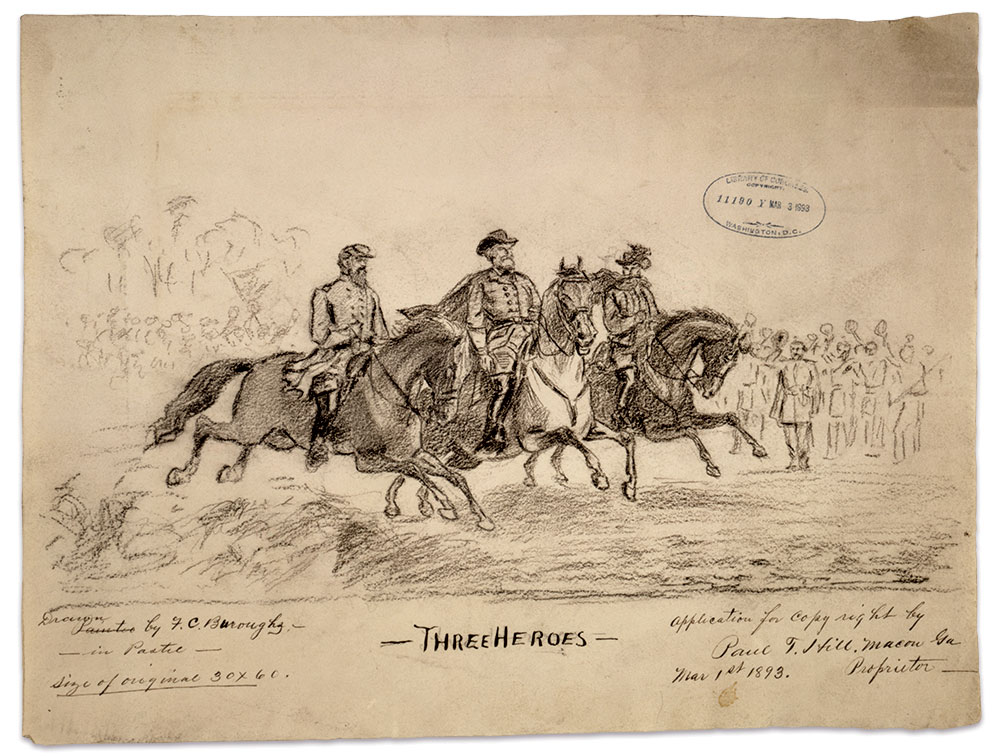
When Stuart laid down that night to get some sleep under a modest tent fly, it is easy to imagine he dreamed of dancing Southern belles mixed with music and pageantry.
Musketry shattered his dream state the following morning. The gunfire, from Union Maj. Gen. Alfred Pleasonton’s 11,000-man cavalry corps, caught the Confederates unaware. A desperate struggle unfolded in several acts through the day. When the curtain closed, Stuart held the ground and Pleasonton retreated, leaving the plains of Brandy Station littered with dead from both sides. Altogether some 1,300 troopers became casualties, 866 Union and 433 Confederate. The largest cavalry engagement on North American soil ended in a draw.
Stuart’s surprise at Brandy Station might be considered a harbinger of what was to come.
Days later, long columns of gray infantrymen, followed by wagons full of supplies, moved northward. Men in the ranks were oblivious to the goals and objectives of the march, which had been planned out well before the Battle of Brandy Station.
General Lee, in conferences with President Jefferson Davis, Secretary of War James Seddon, and eventually the full Cabinet, laid out plans to achieve Confederate victory north of the Mason-Dixon Line—a second attempt following the failed Antietam Campaign less than a year earlier.
“Stuart received orders to advance on the army’s flank, and if practical, protect the mountain passes and screen its movements into Maryland and Pennsylvania.”
Success this time would encourage European nations to recognize the Confederacy and compel President Abraham Lincoln and his administration to negotiate peace and independence of the Southern nation.
Stuart received orders to advance on the army’s flank, and if practical, protect the mountain passes and screen its movements into Maryland and Pennsylvania.
The hopes and dreams that rode and marched with Stuart, Lee, and the Army of Northern Virginia ended in Pennsylvania. During the momentous clash in the environs of the crossroads community of Gettysburg, tens of thousands were slain, maimed, and missing. Singular engagements over the three-day battle added new names to the American vocabulary: Culp’s Hill. The Wheatfield. Devil’s Den. The Peach Orchard. Little Round Top. Pickett’s Charge.
Stuart’s corps, riding in dramatic fashion in a sprawling arc around the eastern flank of the Union Army of the Potomac, contributed little intelligence of the enemy’s whereabouts to Lee. Stuart arrived at Gettysburg about noon on the second day of the battle—too late to save the day or change the final outcome of the fight.
The road to Hagerstown
The Army of Northern Virginia evacuated Gettysburg during the rainy afternoon of July 4, 1863. The withdrawal, along with the capitulation of the garrison of Vicksburg the same day, effectively ended the drive for Southern independence and Confederate nationhood.
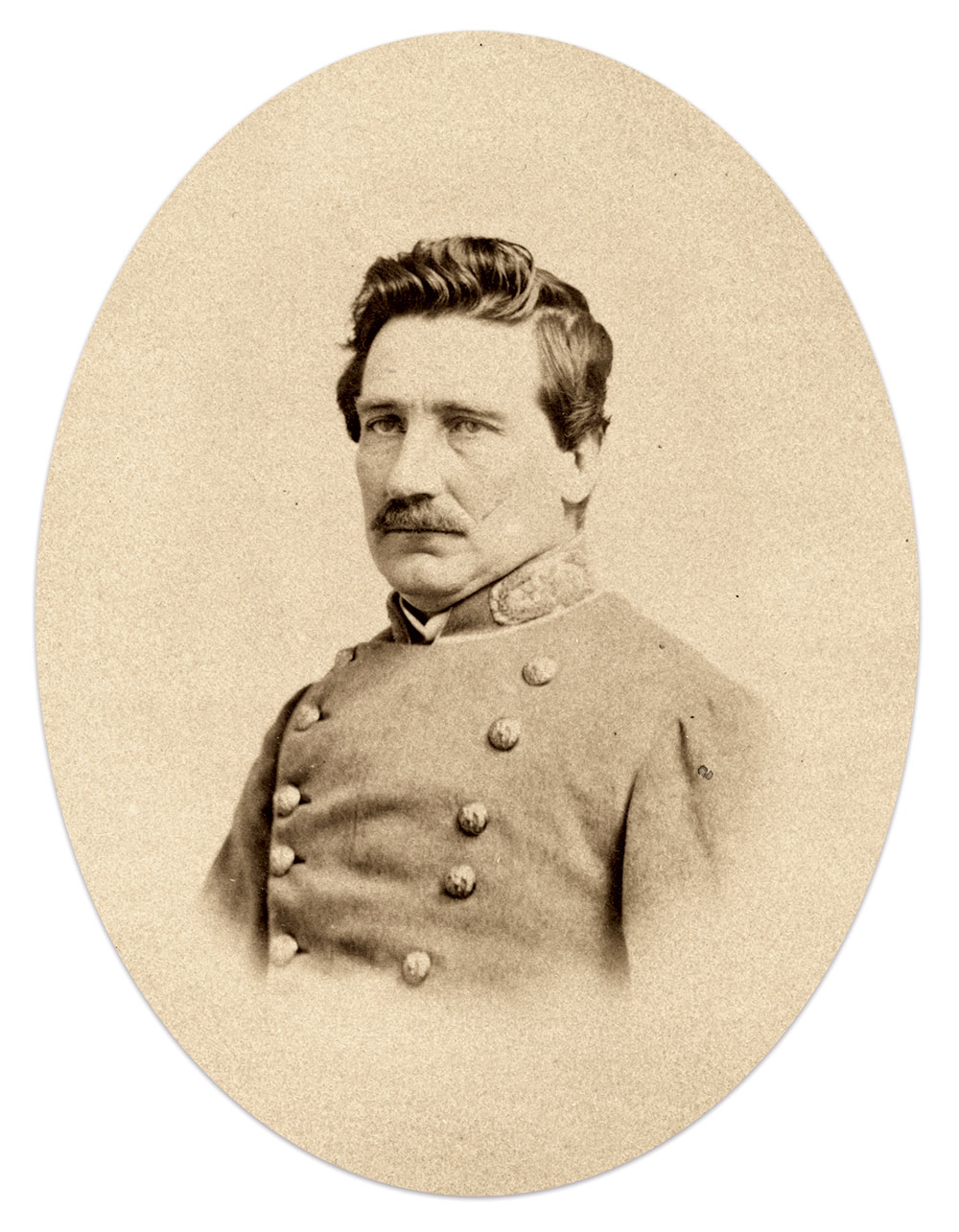
Lee moved with all possible dispatch to Virginia to rest, recuperate, and fight another day. A wagon train of wounded stretched for 17 miles along muddy roads leading out of town. The brigadier general commanding its 2,100-man escort, John D. Imboden, had orders not to stop until reaching Williamsport, Md., where it would cross the Potomac River into Virginia and head south to Winchester.
Along the way, the fatigued, defeated men scourged the land like locusts, leaving a path of destruction in their wake. Broken wagons, dead horses, and discarded weapons littered the roadside as they make their frantic escape.
The Confederates had an unexpected tailwind: Army of the Potomac commander George G. Meade held a council of war the same night as the wagon train snaked south. Meade decided that only his cavalry should pursue Lee until actionable intelligence could be obtained.
The Union troopers dispatched by Meade included the 5th New York Cavalry. On the morning of July 5, the New Yorkers encountered elements of Brig. Gen. Albert Jenkins’ cavalry brigade near Monterey Gap on the Pennsylvania-Maryland border. In the sharp clash that ensued, the chaplain of the 5th, Louis N. Boudrye, fell into Confederate hands.
“General S. is a fine-looking officer. His features are distinct in outline, his nose long and sharp. His eyes keen and restlessly on the lookout. His complexion is florid. He wears a gray plush hat with a black feather; has plain uniform, and a short bowie knife by his side with ivory handle attached to his person by a golden chain.”
—Chaplain Louis N. Boudrye, 5th New York Cavalry
Boudrye described the circumstances in his diary. “I was completely surrounded by the enemy and captured, I thought that being a chaplain and my horse was my own property and not the Federal Governments’, it was promised to me that as soon as I reached General Stuart’s Headquarters, I would be released and none of my property would be molested. True as the chivalry are able to keep to their promises, on reaching the general, I was immediately released of my horse and all hopes of liberty.”
The captured chaplain plead to be released in a personal interview with Stuart, who refused. Boudrye described the encounter in a letter written days later: “General S. is a fine-looking officer. His features are distinct in outline, his nose long and sharp. His eyes keen and restlessly on the lookout. His complexion is florid. He wears a gray plush hat with a black feather; has plain uniform, and a short bowie knife by his side with ivory handle attached to his person by a golden chain. He seems to trust no man to do what he can possibly do himself. But there is more chivalry in the exterior than the interior, I fear.”
Another Union officer, 1st Lt. Louis R. Fortesque of the Signal Corps, had been captured near Emmitsburg, Md. He described an encounter with Stuart in his July 6 diary entry: “Arriving at the intersection of the first street, we were confronted by the cavalry leader of the Army of Northern Virginia, whose headquarters were temporarily established there. To those of us who have never had the misfortune of an introduction under such unfavorable conditions, his appearance might have awakened adulatory criticism, particularly by believers in his theory of southern rights. But to us his self-assertion and bombastic exaggeration of dress simply invited contempt. In stature he was six feet tall and weighed about one hundred ninety pounds. A complexion somewhat ruddy from exposure, with light brown hair, worn rather long, and full flowing beard. His regulation gray uniform was profusely decorated with gold braid, and was topped with a broad-brimmed black felt hat, pinned up at the side with a star from which drooped an extravagantly large ostrich feather. On his left breast was a shield, about two inches in width, which held a chain attached to the handle of a small stiletto, the blade being passed through the button holes of his coat.”
Meanwhile, the weather worked against Lee’s retreating army. Rain continued to fall, at times in torrents, swelling the Potomac to historic levels and preventing the planned crossing at Williamsport.
Lee dug in to wait out the rain and the river. The men constructed earthworks from Williamsport to Falling Waters. Stuart’s cavalry covered the front, engaging in a series of fights, mostly dismounted skirmishes and artillery exchanges, in the vicinity of Funkstown, Boonsborough, and Hagerstown.

A pause in Hagerstown
Constant contact with the enemy took a toll on Stuart and his troopers. They had traveled 300 miles in 30 days with broken sleep and scant rations. To add to their woes, they had the added pressure of having their backs against the Potomac while the army waited for the river to recede.
Stuart’s chief of staff, Maj. Henry B. McClellan, recalled in his memoirs how the frenetic pace affected his boss. At the Hagerstown home of a Southern man with Confederate sympathies, a young lady prepared supper for Stuart, McClellan and other staff. Stuart fell asleep on a couch in a parlor and did not rise when the meal was ready. McClellan, knowing the general had not eaten all day, helped him to the table. Stuart ate sparingly, and, when offered a hard-boiled egg, regained his senses and asked for four or five. He ate one before leaving the table and repairing to the parlor. McClellan and the others joined him. McClellan took a seat at a piano and began to play and sing “If You Want to Have a Good Time, Jine the Cavalry.” This perked up Stuart, who joined in the singing with relish.
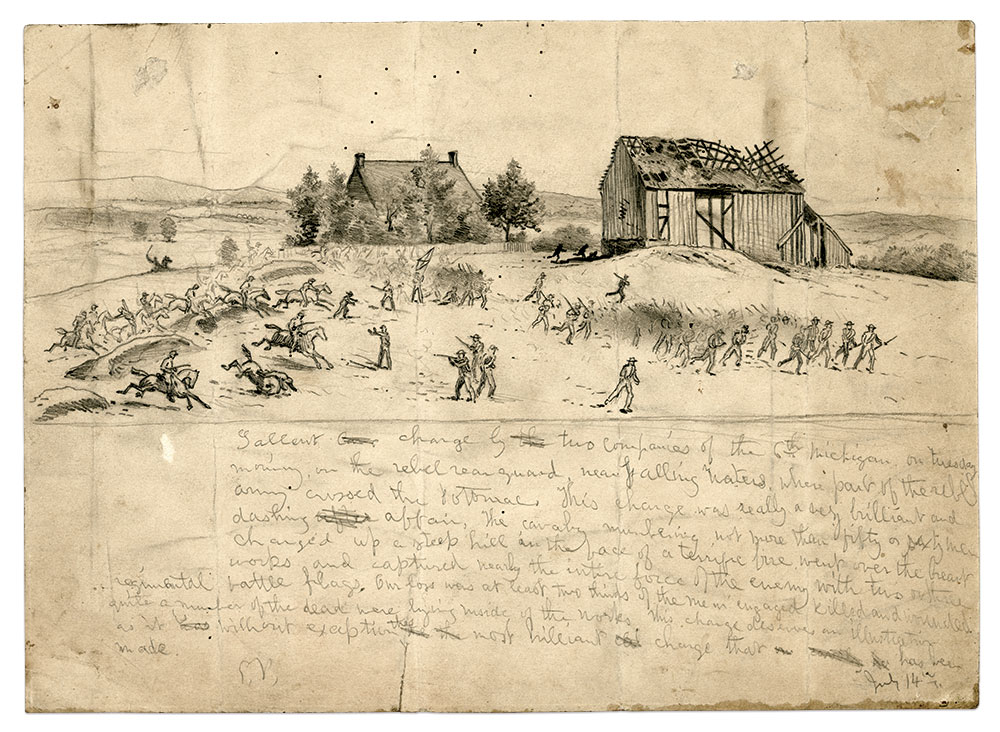
McClellan documented another, similar event that occurred about the same time. Rousing Stuart at a late hour, McClellan shared brigade orders for Stuart’s sign-off. The general drifted in and out of sleep during the document review before McClellan stirred him from his slumber to complete the task.
At other times, Stuart exuded high energy and expressed himself with great vigor. He wrote Flora two letters while the struggle of battle swirled around him near Hagerstown: Once on July 10 and again on the 13th. In the latter letter, upbeat and lengthy, he detailed a laundry list of things that he had purchased for her, and mentioned he had a horse shot out from under him near Funkstown. He shared highlights of his time in Pennsylvania and staff news, boasting that his cavalry was the finest body of men on the planet.
By the next day, July 14, the waters of the Potomac had lowered and most of Lee’s army had crossed. Stuart and his cavalry joined them.
Stuart would never cross the river again. He’d never know the final outcome of the war, suffering a mortal wound at the Battle of Yellow Tavern a year later.
The standing Stuart portrait
At some point while he waited for the Potomac’s waters to recede, Stuart posed for this portrait in photographer Elias M. Recher’s studio near Hagerstown’s main square.
This is the only time during the war that Stuart is documented to have been in Hagerstown. He had been close on two other occasions the previous year: In September 1862 during the Antietam Campaign, and in October during his raid on Chambersburg, Pa.
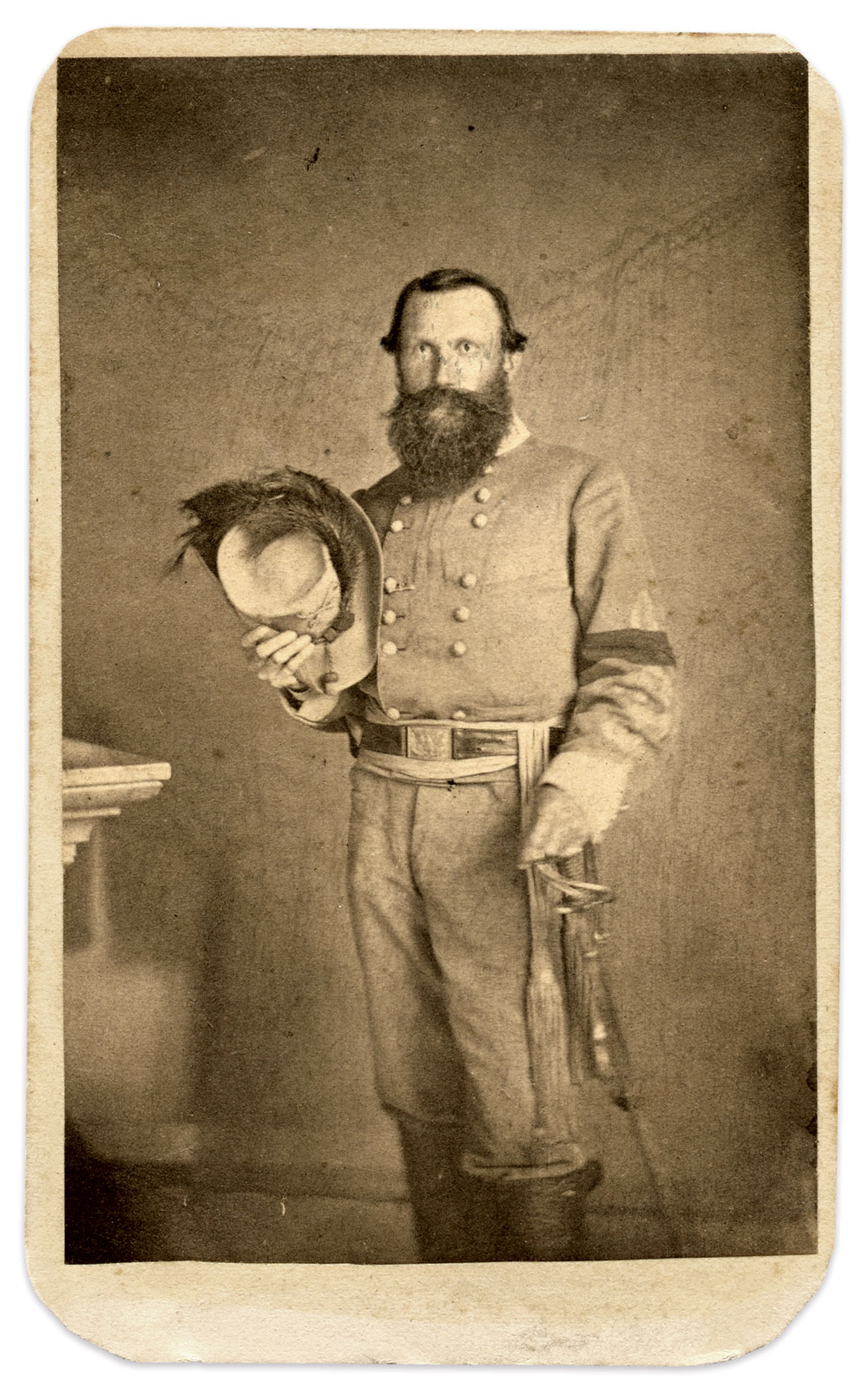
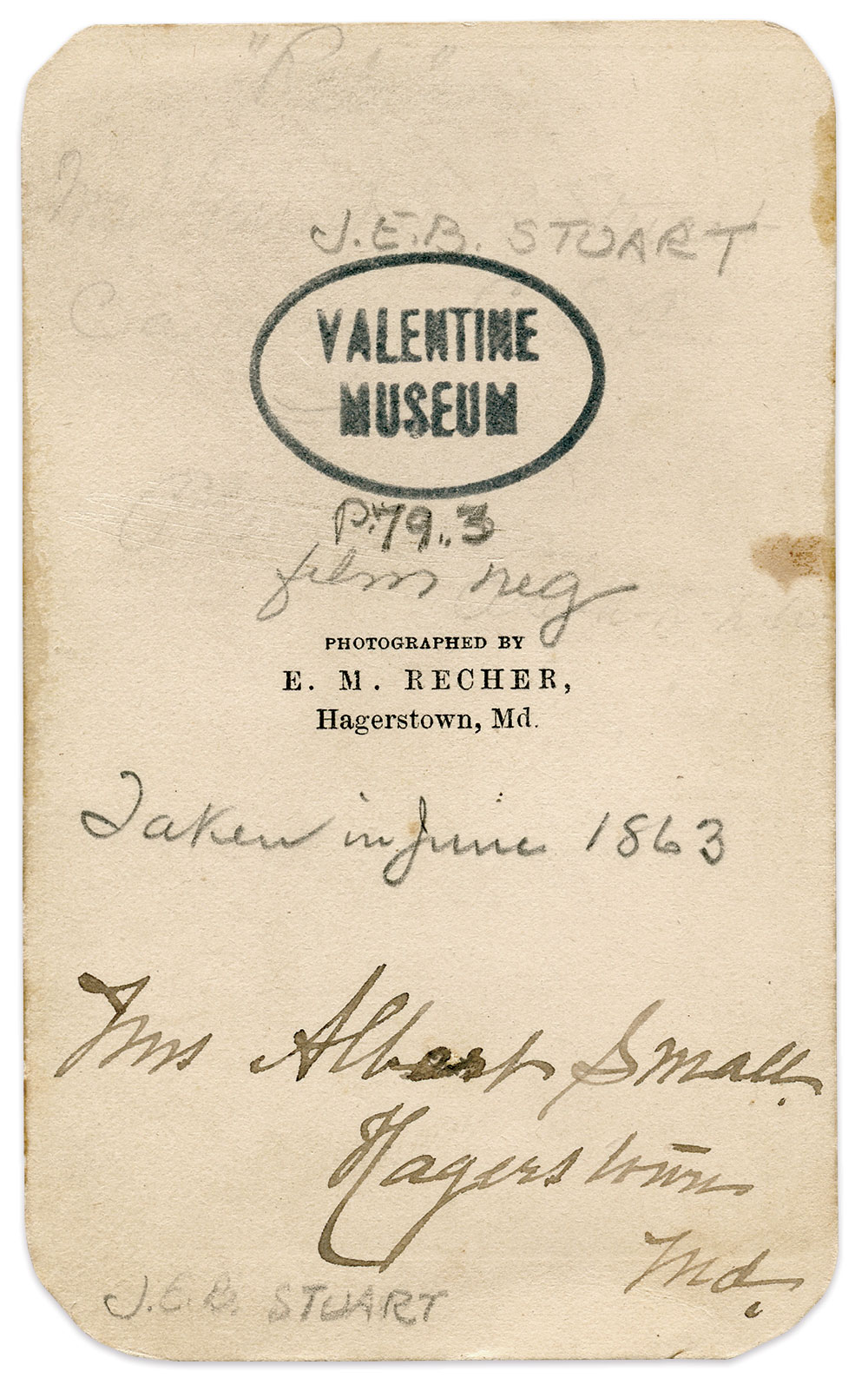
Evidence supporting that the photograph was not taken in late 1862 is compelling: Federal forces occupied Hagerstown when Stuart and his troopers raided Chambersburg, and no one close to him died in September or October, negating any need to wear mourning crepe around his uniform sleeve. His daughter, five-year-old Flora, succumbed to typhoid in early November, after the conclusion of the raid.
Stuart was not the only high-ranking Confederate in Hagerstown during the Gettysburg Campaign, according to photographer Bascom William Tell Phreaner. A teenaged assistant to Recher during the war, he recalled in a 1911 interview: “I was in the studio as a boy learning the art when two very notable men came to be photographed. They were Gen. Jubal Early and Colonel Mosby. I think it was on the return from Gettysburg that they visited Recher’s studio, in which I got my first training.” Phreaner does not mention Stuart. He also places Early and John Singleton Mosby in town after the battle, but there is no other confirmation of their presence at this time. Early, however, was in Hagerstown in late June as the army invaded Pennsylvania.
The June 1863 date is connected to a second surviving Stuart carte is in the Valentine Museum in Richmond. The back of the mount includes the Recher imprint and an inscription by Edward V. Valentine, a sculptor and brother of the museum’s founder, Mann S. Valentine II. Edward, who served as the museum’s first president, noted that the portrait was taken in June 1863 and given to him by Alice A. Small of Hagerstown. Her husband, Albert, was an attorney active in the Republican Party. The June 1863 date may have been passed along by Mrs. Small when she presented the carte to Valentine.
Photographer Elias Marken Recher, 35, had moved with his wife and son to Hagerstown from nearby Wolfsville a few years before the war. He set aside his profession as a teacher to study photography, and, in 1857, opened a gallery on the east corner of the main square.
Recher prospered. In January 1863, four months after the nearby Battle of Antietam, he purchased a home on West Franklin Street, a two-block walk from his studio.
By this time, Recher had embraced the albumen carte de visite format, which had come into vogue. Examples of his work are known for quality and recognizable by the lone curtain-draped column and his imprint on the back of the card stock mount, variously marked “Photographed by E.M. Recher, Hagerstown, Md.,” and “E.M. Recher, Photographic Artist, Hagerstown, Md.” This example incudes the latter backmark.
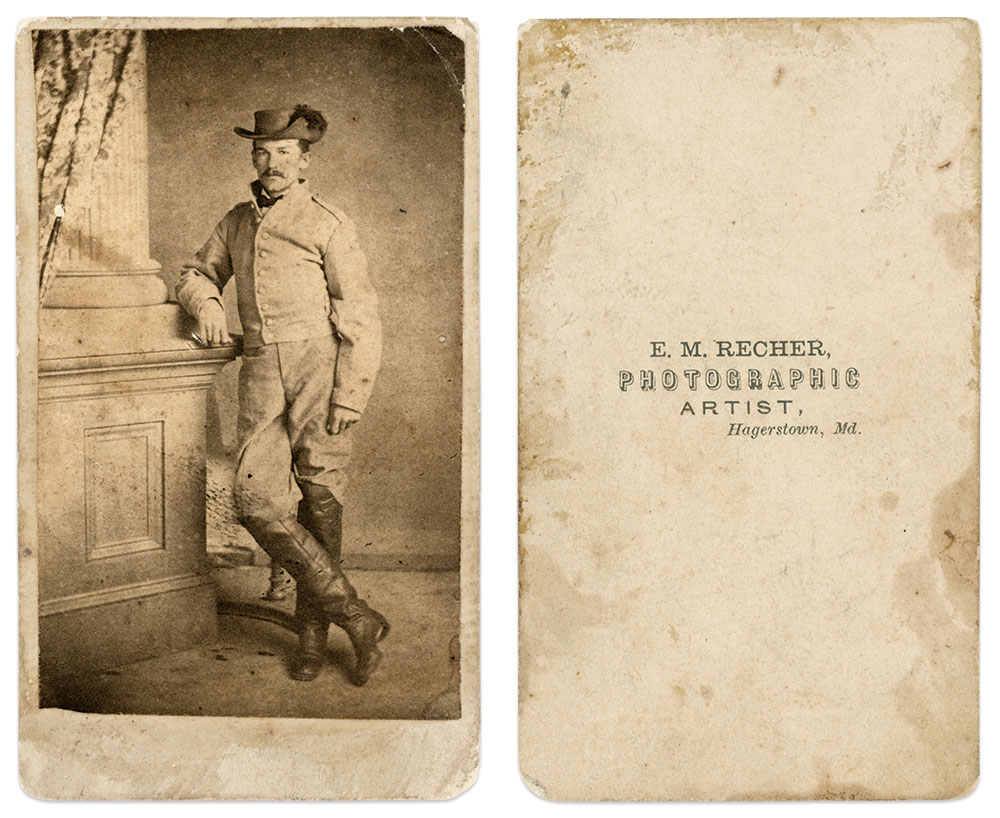
In this portrait, Stuart rests one hand upon his saber, a reminder that he is committed to the cause for which he fights. He stands next to a column with one part of its capital visible. The style of the capital matches other portraits with the Recher imprint.
In studying the general’s attire, the journeyman researcher will immediately notice that the slightly wrinkled uniform was not typical for Stuart. The buttoned-up gray coat with two rows of nine buttons is per the Confederate military regulations for a major general, yellow sash, and low-cut boots with tucked in gray dress pants have not been seen in other images of him. He is pictured in all his other known portraits wearing an open or unbuttoned coat, knee-high cavalry boots, and dark blue trousers prescribed for Confederate general officers.
The color of Stuart’s hat is notable. Wartime and postwar primary sources vary in describing the broad brimmed slouch hat as black or whitish, soft or drab in color.
The aforementioned prisoners of war, Chaplain Boudrye of the 5th New York Cavalry and 1st Lt. Fortesque of the U.S. Signal Corps, described the hat as gray or black.
George M. Neese of Chew’s Battery, Stuart’s Horse Artillery, in his 1911 book Three Years in the Confederate Horse Artillery, notes that the general wore “a long black ostrich feather plume that waved gracefully from a black slouch hat cocked up on one side, and was held with a golden clasp which also stayed the plume” at the Brandy Station review.
Another attendee at the Brandy Station review, an unnamed woman interviewed by journalist Myrta Lockett Avary in her 1903 book, A Virginia Girl in the Civil War, 1861-1865, does not mention the color, only the style: “His hat, a soft, broad-brimmed flat, was caught up at the side with a gold star and carried a sweeping plume.”
Trusted staffer Heros Von Borcke described Stuart’s hat in his 1893 book, The Great Cavalry Battle at Brandy Station June 9, 1863: “On the head with slightly curled brown hair, a wide-brimmed, light, gray felt hat, one cuff raised up and one of them with black Ostrich feathers cascading down.”
The general may be wearing one of the new uniforms that was ordered for him to wear in the Brandy Station review. Or perhaps it was another uniform he mentioned to Flora in a letter written on September 4, 1863.
Black crepe wrapped around his coat sleeve indicates Stuart is in mourning. His uncovered head and hat in hand adds to the impression that he is paying respect for a deceased person. Who that person was is a mystery. One explanation is that Stuart mourned Pelham and or Price, both of whom died in the spring. Though the 30-day period of mourning had passed, Stuart may have taken this opportunity to be photographed to remember his departed staffers. If so, this image is a memento of his sorrow and mourning.
Research continues into the origin story of this photograph.
Based on the evidence presented here, I believe photographer Elias M. Recher caught lightening in a bottle after JEB Stuart stood before the lens in his Hagerstown studio that July day in 1863, capturing on glass negative and albumen paper Stuart’s emotions and personae at a pivotal moment in his career and the Confederacy’s history.
Special thanks to Stephen Recker and Stephen R. Bockmiller.
References: Trout, The Story of Frank Smith Robertson of Jeb Stuart’s Staff; Von Borcke, Memoirs of the Confederate War for Independence, Vol. II; Williamson, Life of J.E.B. Stuart; Boudrye, Historic Records of the Fifth New York Cavalry; Brown, The Signal Corps in the War of the Rebellion; Nesbitt, Saber and Scapegoat: J.E.B. Stuart and the Gettysburg Convention; McClellan, The Life and Campaigns of Major-General J.E.B. Stuart; Von Borcke, Die Grosse Reiterschlacht Bei Brandy Station 9 Juni 1863 (The Great Cavalry Battle at Brandy Station June 9, 1863); Neese, Three Years in the Confederate Horse Artillery; Avary, A Virginia Girl in the Civil War, 1861-1865.
Phil McCoy is a collector of Confederate images who lives in Paris, Ky. His award-winning Civil War show displays include Brig. Gen. John Hunt Morgan’s men. “Men of War: Selected image groupings from the Phil McCoy Collection,” appeared in the Spring 2023 issue of MI.
SPREAD THE WORD: We encourage you to share this story on social media and elsewhere to educate and raise awareness. If you wish to use any image on this page for another purpose, please request permission.
LEARN MORE about Military Images, America’s only magazine dedicated to showcasing, interpreting and preserving Civil War portrait photography.
VISIT OUR STORE to subscribe, renew a subscription, and more.

